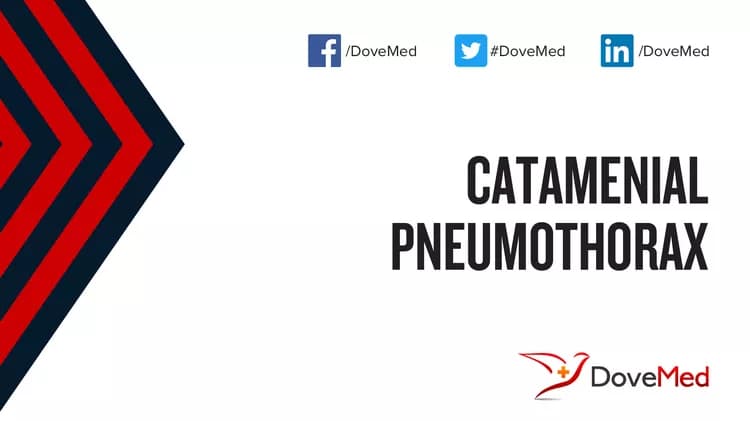What are the other Names for this Condition? (Also known as/Synonyms)
- CPT (Catamenial Pneumothorax)
What is Catamenial Pneumothorax? (Definition/Background Information)
- Catamenial Pneumothorax (CPT) is an extremely rare condition that affects women. Women with CPT have recurrent episodes of pneumothorax that occur within 72 hours before or after the start of menstruation
- Pneumothorax is the medical term for a collapsed lung, a condition in which air or gas is trapped in the space surrounding the lungs causing the lungs to collapse
- The exact cause of Catamenial Pneumothorax is unknown and several theories have been proposed
- Many cases are associated with the abnormal development of endometrial tissue outside of the uterus (endometriosis). Some believe that Catamenial Pneumothorax is the most common form of thoracic endometriosis (a condition in which the endometrial tissue grows in or around the lungs)
- A diagnosis of Catamenial Pneumothorax is usually suspected when a woman of reproductive age and with endometriosis has episodes of pneumothorax
- Treatment is with hormones and surgery
(Source: Catamenial Pneumothorax; Genetic and Rare Diseases Information Center (GARD) of National Center for Advancing Translational Sciences (NCATS), USA.)
Who gets Catamenial Pneumothorax? (Age and Sex Distribution)
- Catamenial Pneumothorax is a rare disorder affecting women
- The presentation of symptoms may occur during a woman’s reproductive years
- Worldwide, individuals of all racial and ethnic groups may be affected
What are the Risk Factors for Catamenial Pneumothorax? (Predisposing Factors)
The risk factors for Catamenial Pneumothorax may include the following:
- Female gender
- Endometriosis
- Menstrual cycle
It is important to note that having a risk factor does not mean that one will get the condition. A risk factor increases one’s chances of getting a condition compared to an individual without the risk factors. Some risk factors are more important than others.
Also, not having a risk factor does not mean that an individual will not get the condition. It is always important to discuss the effect of risk factors with your healthcare provider.
What are the Causes of Catamenial Pneumothorax? (Etiology)
The exact cause of Catamenial Pneumothorax is not known. However, several theories have been proposed:
- The migration of endometrial tissue from the uterus to the pleural space, causing thoracic endometriosis. This theory is supported by the fact that the majority of women with Catamenial Pneumothorax are observed to have endometriosis
- Hormonal fluctuations during menstruation, specifically, prostaglandin F2, which causes constriction of airways, which may lead to the collapse of air sacs
- Hormonal fluctuations during menstruation leading to rupture of blebs in the lungs, which may cause airways to collapse. Blebs are tiny sub-pleural structures (1-2cm in diameter), filled with air
- Movement of air from the genital tract to the pleural space, as a result of the absence of the mucus plug. The mucus plug in the cervix acts as a protective barrier to the female reproductive system
What are the Signs and Symptoms of Catamenial Pneumothorax?
The signs and symptoms of Catamenial Pneumothorax may include:
- Dysmenorrhea
- Endometriosis
(Source: Catamenial Pneumothorax; Genetic and Rare Diseases Information Center (GARD) of National Center for Advancing Translational Sciences (NCATS), USA.)
The following signs and symptoms may occur before, during, and immediately after menstruation:
- Chest pain
- Shortness of breath
- Cough
- Dizziness
- Lethargy
How is Catamenial Pneumothorax Diagnosed?
- The diagnosis of Catamenial Pneumothorax should be suspected in women of reproductive age who have several episodes of spontaneous lung collapse (pneumothoraces) and have endometriosis
- Medical thoracoscopy or video-assisted thoracoscopy may confirm the diagnosis
(Source: Catamenial Pneumothorax; Genetic and Rare Diseases Information Center (GARD) of National Center for Advancing Translational Sciences (NCATS), USA.)
Many clinical conditions may have similar signs and symptoms. Your healthcare provider may perform additional tests to rule out other clinical conditions to arrive at a definitive diagnosis.
What are the possible Complications of Catamenial Pneumothorax?
The complications of Catamenial Pneumothorax may include:
- Severe breathing difficulties
- Compromised lung function
Complications may occur with or without treatment, and in some cases, due to treatment also.
How is Catamenial Pneumothorax Treated?
- The treatment of choice for Catamenial Pneumothorax is with surgery, with video-assisted thoracoscopic surgery (VATS)
- Conventional thoracotomy may be occasionally necessary, particularly in repeat operations. It is very important to examine the large, thin tissue lining around the outside of the lungs and the inside of the chest cavity (pleura)
- Hormonal treatment with surgery prevents the repeat of catamenial and/or endometriosis-related pneumothorax. Gonadotrophin-releasing hormone (GnRH) for 6 to 12 months after the surgery is also often recommended
(Source: Catamenial Pneumothorax; Genetic and Rare Diseases Information Center (GARD) of National Center for Advancing Translational Sciences (NCATS), USA.)
How can Catamenial Pneumothorax be Prevented?
- At the present time, there are no guidelines or methods available for the prevention of Catamenial Pneumothorax
- Regular medical screening at periodic intervals with tests and physical examinations are recommended
- Active research is currently being performed to explore the possibilities for treatment and prevention of disorders such as Catamenial Pneumothorax
What is the Prognosis of Catamenial Pneumothorax? (Outcomes/Resolutions)
- The prognosis of Catamenial Pneumothorax may be good, if the condition can be successfully treated with surgery and/or hormones
- In some women, complications of pneumothorax can occur, which may be life-threatening
Additional and Relevant Useful Information for Catamenial Pneumothorax:
The following DoveMed website link is a useful resource for additional information:
Related Articles
Test Your Knowledge
Asked by users
Related Centers
Related Specialties
Related Physicians
Related Procedures
Related Resources
Join DoveHubs
and connect with fellow professionals


0 Comments
Please log in to post a comment.